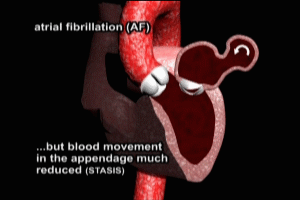Atrial Fibrillation and Stroke CVS103
Atrial Fibrillation and Stroke Transcript
Atrial Fibrillation and Stroke
This is Dr. Cal Shipley with a review of atrial fibrillation of the heart and subsequent embolization of clot to the brain causing stroke.
Cardiac Anatomy
Let’s take a look at a little bit of cardiac anatomy to set things up.
Here we see the left ventricle and the left atrium, the small chamber on top, with the atrial appendage. In cross-section, we see the left atrium, and we’ve unfolded the atrium here for clarity to show how the atrial appendage is kind of an extended chamber off the atrium itself.
Direction of Blood Flow
The blood flow goes from the left atrium into the left ventricle, and then the left ventricle pushes blood up into the aorta, and hence, to the brain via the carotid, and vertebrobasilar arteries (as we discussed previously).
The anatomy and flow characteristics make clear any clots or particles which are formed in (or enter into) the heart have a really good chance of being pumped right up into the vessels of the brain.
Atrial Fibrillation and Stroke
Unlike normal heart rhythm, in atrial fibrillation, the atrial chamber quivers, or fibrillates, at a much higher rate than the ventricles. Moreover, the fibrillating atrium is much less effective in injecting blood into the ventricle just prior to ventricular contraction (also known as systole). The beating left ventricle continues to draw blood through the main chamber of the atrium.
However, in the appendage, blood movement is much slowed, a condition known as blood stasis. Stasis in the left atrial appendage greatly increases the chance for clot formation. As demonstrated here, many clots are initially adherent to the wall of the fibrillating atrium. An adherent clot, also known as a thrombus, may unpredictably detach itself from the wall of the atrium, enter the left ventricle, and then be ejected up into the aorta, and hence, to the brain.
The tendency for thrombus detachment and ejection increases if the atrium suddenly reverts to a normal rhythm. Once detached, the thrombus now travels, or embolizes, to the arteries of the brain. Along the way, the embolus, as it is now known, may fragment into many smaller pieces with only those of significant size causing obstruction to blood flow. In this example, one embolus has lodged in the right middle cerebral artery resulting in a stroke as noted on this CT scan. The dark oval shape indicates the area of stroke.
Cal Shipley, M.D. copyright 2020

